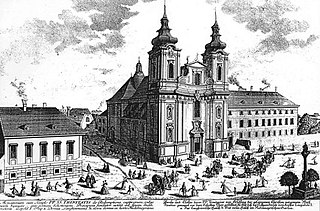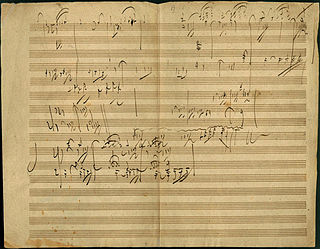
Franz Peter Schubert was an Austrian composer of the late Classical and early Romantic eras. Despite his short lifetime, Schubert left behind a vast oeuvre, including more than 600 secular vocal works, seven complete symphonies, sacred music, operas, incidental music, and a large body of piano and chamber music. His major works include "Erlkönig", the Piano Quintet in A major, D. 667 , the Symphony No. 8 in B minor, D. 759 , the ”Great” Symphony No. 9 in C major, D. 944, the String Quintet, the three last piano sonatas, the opera Fierrabras, the incidental music to the play Rosamunde, and the song cycles Die schöne Müllerin and Winterreise.
The curse of the ninth is a superstition connected with the history of classical music. It is the belief that a ninth symphony is destined to be a composer's last; that the composer will be fated to die while or after writing it, or before completing a tenth.

Paul Felix Weingartner, Edler von Münzberg was an Austrian conductor, composer and pianist.

The Symphony No. 9 in C major, D 944, known as the Great(first published by Breitkopf & Härtel in 1849 as "Symphonie / C Dur / für großes Orchester",listed as Symphony No. 8 in the Neue Schubert-Ausgabe), is the final symphony completed by Franz Schubert. Originally called The Great C major to distinguish it from his Symphony No. 6, the Little C major, the subtitle is now usually taken as a reference to the symphony's majesty. Unusually long for a symphony of its time, a typical performance of The Great lasts an hour when all repeats indicated in the score are taken. The symphony was not professionally performed until a decade after Schubert's death.

Franz Schubert's Symphony No. 8 in B minor, D. 759, commonly known as the Unfinished Symphony, is a musical composition that Schubert started in 1822 but left with only two movements—though he lived for another six years. A scherzo, nearly completed in piano score but with only two pages orchestrated, also survives.
An unfinished symphony is a fragment of a symphony, by a particular composer, that musicians and academics consider incomplete or unfinished for various reasons. The archetypal unfinished symphony is Franz Schubert's Symphony No. 8, written in 1822, six years before his death. It features two fully orchestrated movements. While it seems clear from sketches that Schubert set out to create a traditional four-movement symphony, this has been the subject of endless debate. Schubert wrote the symphony for the Graz Musical Society, and gave the manuscript to his friend Anselm Hüttenbrenner, in his capacity as its representative. However, Hüttenbrenner did not show the score to the society at that time, nor did he reveal the existence of the manuscript after Schubert died in 1828, but kept it a secret for another 37 years. In 1865, when he was 76, Hüttenbrenner finally showed it to the conductor Johann von Herbeck, who conducted the extant two movements on 17 December 1865 in Vienna, adding the last movement of Schubert's third symphony as the finale. Music historians and scholars then toiled to "prove" the composition was complete in its two-movement form, and indeed, in that form it became one of the most popular pieces in the late 19th century classical music repertoire, and remains one of Schubert's most popular compositions.

The String Quartet No. 13 in A minor, D 804, Op. 29, was written by Franz Schubert between February and March 1824. It dates roughly to the same time as his monumental Death and the Maiden Quartet, emerging around three years after his previous attempt to write for the string quartet genre, the Quartettsatz, D 703, that he never finished.

In music theory, voicing refers to two closely related concepts:
- How a musician or group distributes, or spaces, notes and chords on one or more instruments
- The simultaneous vertical placement of notes in relation to each other; this relates to the concepts of spacing and doubling

Franz Schubert wrote his Sonata in C major for piano four-hands, D 812, in June 1824 during his second stay at the Esterházy estate in Zseliz. The extended work, in four movements, has a performance time of around 40 to 45 minutes. It was published as Grand Duo, Op. 140, in 1837, nine years after the composer's death.
Symphony No. 7 is the name given to a four-movement symphony in E major drafted by Franz Schubert in August 1821. Although the work is structurally complete, Schubert only orchestrated the slow introduction and the first 110 bars of the first movement. The rest of the work is continued on 14-stave score pages as a melodic line with occasional basses or counterpoints, giving clues as to changes in orchestral texture.

Schubert's Symphony No. 10 in D major, D 936A, is an unfinished work that survives in a piano sketch. Written during the last weeks of the composer's short life, it was only properly identified in the 1970s. It has been orchestrated by Brian Newbould in a completion that has subsequently been performed, published and recorded.
Franz Schubert's Symphony No. 4 in C minor, D 417, called by its composer the Tragic, was completed in April 1816, a year after his Third Symphony, when he was 19 years old. However, it was not premiered until November 19, 1849, in Leipzig, more than two decades after Schubert's death.
Franz Schubert's Piano Sonata in C major, D. 840, nicknamed "Reliquie" upon its first publication in 1861 in the mistaken belief that it had been Schubert's last work, was written in April 1825, whilst the composer was also working on the A minor sonata, D. 845 in tandem. Schubert abandoned the C major sonata, and only the first two movements were fully completed, with the trio section of the third movement also written in full. The minuet section of the third movement is incomplete and contains unusual harmonic changes, which suggests it was there Schubert had become disillusioned and abandoned the movement and later the sonata. The final fourth movement is also incomplete, ending abruptly after 272 measures.
The Piano Sonata in E major, D 157 is a piano sonata with three movements composed by Franz Schubert in February 1815. The Allegro D 154 is an early version of its first movement.
Brian Newbould is a composer, conductor and author who has conjecturally completed Franz Schubert's Symphonies D 708A in D major, No. 7 in E major, No. 8 in B minor ("Unfinished") and No. 10 ("Last") in D major. He was educated at Gravesend Grammar School, and earned a BMus degree with top honors from the University of Bristol.

Mass No. 6 in E-flat major, D 950, is a mass composed by Franz Schubert, a few months before his death. It is scored for two tenor soloists, soprano, alto and bass soloists, SATB choir with divisi, 2 oboes, 2 clarinets, 2 bassoons, 2 horns, 2 trumpets, 3 trombones, timpani, violin I and II, viola, cello, and double bass. It was Schubert's final setting of the order of Mass, and is classified as a missa solemnis.

Schubert's Symphony in D major, D 708A, is an unfinished work that survives in an incomplete eleven-page sketch written for piano solo. It is one of Schubert's six unfinished symphonies. It was begun in 1820 or 1821, with initial sketches made for the opening sections of the first, second, and fourth movements, and an almost complete sketch for the third movement. He abandoned this symphony after this initial phase of work and never returned to it, although Schubert would live for another seven years. British conductor and composer Brian Newbould, an authority on Schubert's music, has speculated that the symphony was left incomplete due to problems Schubert faced in orchestrating the sketch.
Schubert's Symphony in D major, D 615, is an unfinished work that survives in an incomplete four-page, 259-bar sketch written for piano solo. It is one of Schubert's six unfinished symphonies. It was begun in May 1818, with initial sketches made for the opening sections of the first movement and finale. He abandoned this symphony after this initial phase of work and never returned to it, probably due to dissatisfaction with it, although Schubert would live for another ten years. Although conductor and composer Brian Newbould has made a performing version of the fragments, a full completion has not yet been attempted.
Franz Schubert began thirteen symphonies, of which up to ten are generally numbered, but only completed seven; nonetheless, one of his incomplete symphonies, the Unfinished Symphony, is among his most popular works.

In music, a sketch is an informal document prepared by a composer to assist in the process of composition.











